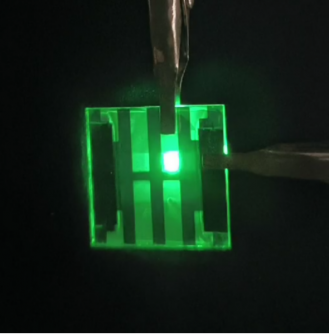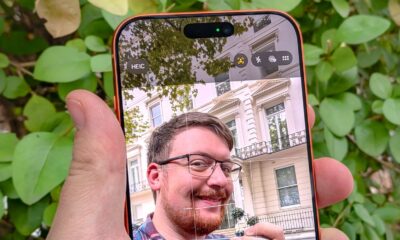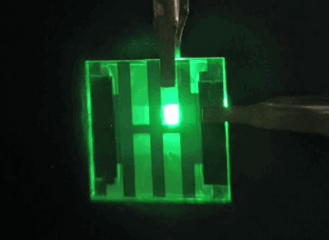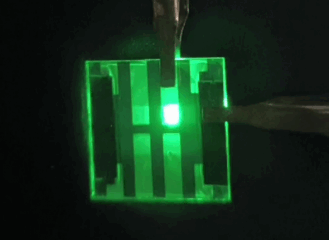Technology
Researchers Create Ultra-Thin LED Mimicking Natural Sunlight

Researchers have developed a groundbreaking paper-thin LED that emits a warm, sun-like glow, potentially transforming how we light indoor spaces. The study, published in ACS Applied Materials & Interfaces, highlights the feasibility of ultra-thin quantum dot LEDs that could enhance phone and computer screens, as well as other lighting sources, while promoting better sleep patterns.
Innovative Design and Functionality
Xianghua Wang, a corresponding author of the study, emphasized the implications of this work, stating, “These devices could enable next-generation eye-friendly displays, adaptive indoor lighting, and even wavelength-tunable sources for horticulture or well-being applications.” The demand for indoor lighting that mimics natural light is growing, as consumers seek a comfortable atmosphere.
Previous attempts to create flexible LEDs involved using phosphorescent dyes that produced a candle-like glow. In contrast, this new approach uses quantum dots, which are semiconductor particles that convert electric energy into colored light. While other researchers have made strides in creating white LEDs with quantum dots, matching the full spectrum of sunlight has remained a challenge.
This new research led by Lei Chen and colleagues aimed to address this issue by developing quantum dots that replicate the natural glow when integrated into thin white quantum dot LEDs (QLEDs). Collaborating with Wang’s team, they devised a strategy for slim, electrically conductive materials that operate at relatively low voltages.
Technical Achievement and Testing
The researchers synthesized red, yellow-green, and blue quantum dots enveloped in zinc-sulfur shells, determining the optimal ratio of these colors to achieve an emission spectrum similar to sunlight. They constructed a QLED on an indium tin oxide glass substrate, layering electrically conductive polymers, the quantum dot mixture, metal oxide particles, and a final layer of aluminum or silver. The quantum dot layer measured only tens of nanometers thick, making the final QLED comparable in thickness to wallpaper.
In initial tests, the ultra-thin QLED performed optimally at an 11.5-volt power supply, producing bright, warm white light. Notably, the emitted light exhibited higher intensity in red wavelengths and lower intensity in blue wavelengths, which is beneficial for sleep and eye health. Objects illuminated by the QLED demonstrated color accuracy, scoring over 92% on the color rendering index.
Further experiments involved creating 26 white QLED devices with the same quantum dots but varying the electrically conductive materials to enhance operating voltage efficiency. Remarkably, these light sources required only 8 volts to achieve maximum brightness, with around 80% surpassing the brightness target for computer monitors.
Funding for this research was provided by the National Natural Science Foundation of China, the Natural Science Foundation of Anhui Province, and the Major Science and Technology Special Project of Zhongshan City.
The American Chemical Society (ACS) plays a pivotal role in advancing scientific knowledge and promoting excellence in science education. Founded in 1876 and chartered by the U.S. Congress, ACS provides access to critical scientific information through its various publications, including peer-reviewed journals and scientific conferences. For further inquiries, registered journalists can access the ACS journalist news portal on EurekAlert! or reach out at [email protected].
-

 Technology3 months ago
Technology3 months agoDiscover the Top 10 Calorie Counting Apps of 2025
-

 Health3 weeks ago
Health3 weeks agoBella Hadid Shares Health Update After Treatment for Lyme Disease
-

 Health1 month ago
Health1 month agoErin Bates Shares Recovery Update Following Sepsis Complications
-

 Technology2 months ago
Technology2 months agoDiscover How to Reverse Image Search Using ChatGPT Effortlessly
-

 Lifestyle3 months ago
Lifestyle3 months agoBelton Family Reunites After Daughter Survives Hill Country Floods
-

 Technology3 months ago
Technology3 months agoMeta Initiates $60B AI Data Center Expansion, Starting in Ohio
-

 Technology2 months ago
Technology2 months agoUncovering the Top Five Most Challenging Motorcycles to Ride
-

 Technology2 months ago
Technology2 months agoHarmonic Launches AI Chatbot App to Transform Mathematical Reasoning
-

 Technology3 months ago
Technology3 months agoRecovering a Suspended TikTok Account: A Step-by-Step Guide
-

 Technology3 weeks ago
Technology3 weeks agoElectric Moto Influencer Surronster Arrested in Tijuana
-

 Technology4 days ago
Technology4 days agoiPhone 17 vs. iPhone 16: How the Selfie Camera Upgrades Measure Up
-

 Technology3 months ago
Technology3 months agoByteDance Ventures into Mixed Reality with New Headset Development













